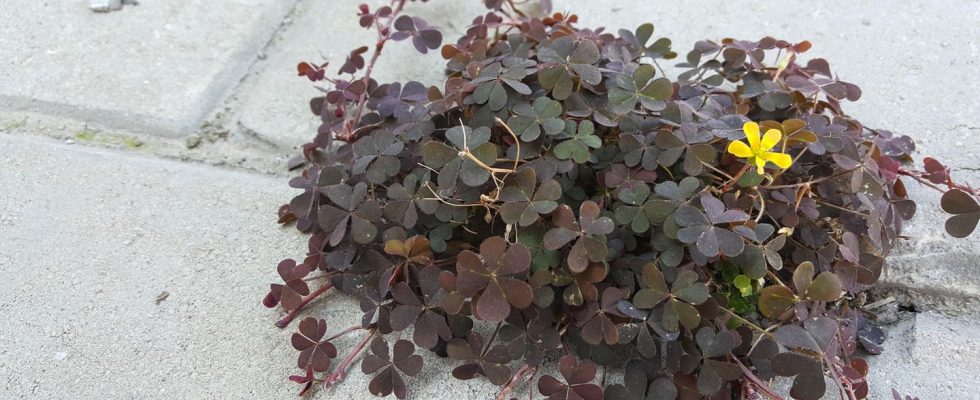Stubborn weeds
Between paving stones, in flower pots or on the lawn: What helps against sorrel?
It is a master at spreading widely: the (horn) sorrel
© Elif Bayraktar/Getty Images
Wood sorrel is a prime example of how a non-native weed can adapt optimally to its new environment: The plant, which comes from the Mediterranean region, survives long dry periods without any problems and spreads rapidly – if it is not stopped.
Horn sorrel (Oxalis corniculata) is a master at sowing itself – and also receives animal support: As soon as the plant has formed its yellow flowers, it throws the ripe seeds meters away. Some of them are then carried away by busy ants. In addition, the so-called neophyte (a non-native species) is not affected by the increasingly hot summers in Germany due to its Mediterranean origins. If it doesn’t rain for a longer period of time, the clover dries up on the surface, but will sprout again as soon as the ground becomes wetter again. Although insects find sorrel tasty, it displaces native plants. Apart from that, the wild growth even grows in paving joints, flower pots and in the lawn. It is therefore important to stop the stubborn weeds in the garden as quickly as possible. We’ll tell you how to do it.
Remove sorrel from (flower) beds
Wood sorrel is often introduced through the purchase of new potted plants. This means it spreads either directly in the flower pot or in the beds after the new plants have been repotted. Since the annoying weeds move above and below ground, quick action is required – ideally before the clover begins to bloom and sow itself: As soon as you discover the red-brown leaves of wood sorrel in your (flower) beds, you should Remove the plant including the deeper root system. You can use special tools such as a Weed cutter or one rake to be helpful.
Tip: Use so-called ground cover to combat weeds. They form a natural carpet of plants that suppress unwanted wild growth.
Remove sorrel from paving joints
The stubborn weed has a bad habit of growing everywhere – even in paving joints. To remove the wood sorrel between the paving stones, you can use one manual or electric joint scraper use. However, you usually don’t get to all of the deep roots. Here the use of one can be used electric weed killer be useful, which destroys the clover due to the strong heat. Alternatively, you can also use one gas-powered weed burner use it, he fights the annoying wild growth with fire. However, it also releases a lot of carbon dioxide.
Tip: With a voucher from Otto you can save money when buying a weed killer.
Remove sorrel from the lawn
Unfortunately, seeds also get lost in the lawn, so wood sorrel grows there. In order to combat weeds in the long term, it is recommended to strengthen the lawn. Not through garden lime, since the neophyte would also survive on calcareous soil. It is better to promote the growth of the grass by adding important nutrients that are available in commercially available products lawn fertilizer can be found. Then let the grass grow for two weeks before mowing it and the clover again. Afterwards, use a scarifier to remove unwanted weeds. And reseed fresh lawn.
Tip: Remove the sod in the areas that are particularly densely overgrown with sorrel and add new topsoil. Then keep the soil moist as clover doesn’t like wet soil.
Using herbicides: yes or no?
The use of herbicides is prohibited on paved paths in Germany. They are allowed on private green spaces and in (flower) beds chemical weed killer Although they are used, they not only attack the sorrel, but also the plants growing around it. It is therefore not advisable to use it. More suitable for combating wood sorrel biological weed killers be based on acetic acid. However, they only destroy the wild growth superficially – the underground root system remains and can therefore sprout again.
Source: My beautiful garden
You might also be interested in:
This article contains so-called affiliate links. Further information are available here.



